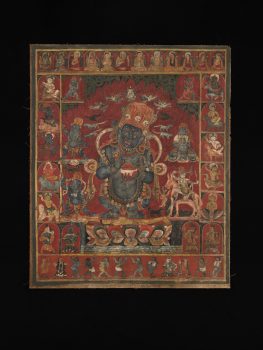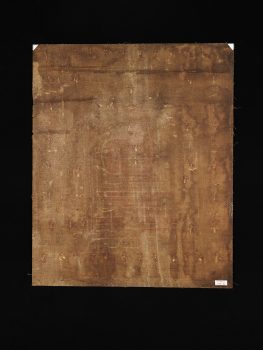Tibet
15th century
A skull cup is an attribute of tantric deities and is usually paired with a curved knife. It can symbolize a mind filled with the bliss of realizing the true nature of reality.
Tibet
15th century


In southern Tibet traditional Nepalese derived thangka painting styles flourished, particularly within the Sakya tradition of Tibetan Buddhism. In this painting, as is typical for Nepalese style (Beri) works, the spaces for the figures are demarcated by yellow lines, and while the flames behind the main figure are not indicative of a particular style, both the blossoms against the blue background to the sides of the lotus and the scrollwork in the area of black background are characteristic of Beri painting as well. A particularly fine detail is the multicolored scarf forming a wide bow behind the head and around the ends of the deity’s magic staff. Panjaranatha Mahakala holds a curved knife and skull cup in front of his chest. His arms support the characteristic magic staff (gandi) that identifies him. The animals around his head are his messengers. Within a halo of flames, Mahakala, or the “Great Black One,” is flanked by four deities: the four armed Bhutadamara Vajrapani and the knife brandishing Mahakala on the left and Ekajata and the four armed Dusolma riding her mule on the right. Above these two pairs are Hevajra (left) and Chakrasamvara (right). The lineage of teachers depicted at the very top attributes the painting to the Sakya tradition. To the sides are the guardians of the directions and the bottom figures are Panjara Mahakala’s retinue.
A religious movement that originated in India around the fifth to seventh century with sacred writings and esoteric teachings and practices transmitted from teacher to student through initiation. These remain an important part of Hinduism and Buddhism today.
A kind of energy that can be used, individually and collectively, to effect change.
Prescribed practices that carry symbolic meaning and value within a specific tradition and are intended to attain a desired outcome. Rituals are usually done as part of a ceremony or regular routine.
Protectors of Buddhist teachings who destroy obstacles that impede the path to enlightenment. The more frightening and gruesome their appearance, the greater their power.
Today, Tibetans primarily inhabit the Tibetan Plateau, situated between the Himalayan mountain range and the Indian subcontinent to the west, Chinese cultural regions to the east, and Mongolian cultural regions to the northeast. During the 7th to 9th century, Tibetan rulers expanded their empire across Central Asia, and established Buddhism as the state religion.
Get the latest news and stories from the Rubin, plus occasional information on how to support our work.